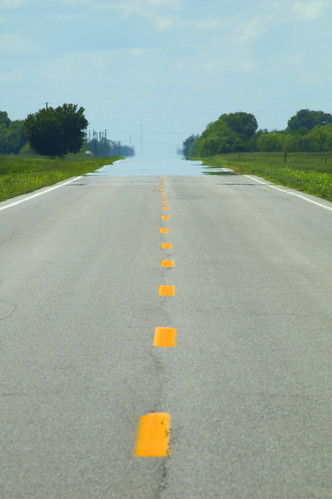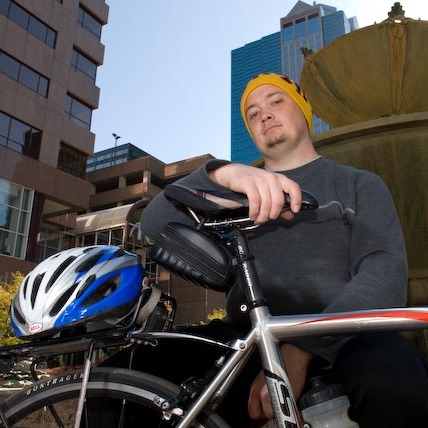 Photo: Disappearing Road, courtesy Brent Danley.
Photo: Disappearing Road, courtesy Brent Danley.
This is a familiar sight for many of us this time of year. We're subjected to sweltering heat that feels like a sticky steam sauna, sun rays broiling us from above and radiant warmth scalding us from below. These conditions are not only trying, but they can be very dangerous as well. This is the polar opposite of navigating ice and snow while fighting hypothermia. Many a cyclist retreats on days like this. Here are some tricks of the trade to keep you safe and healthy when Summer is in full swing.
It's getting hot in here!
Our bodies are designed to operate at a tepid 98.6 degrees Fahrenheit. When the brain heats up to 101 degrees or so, disorientation, dizziness and nausea can set in. A few degrees more and you're completely delirious -- incapable of making rational decisions. This often results in a downward spiral of poor decisions that may result in death. For this reason, it's really important to keep your cool and stay safe in the sun.
You are likely starting to experience heat exhaustion if you start to feel dizzy, confused, crampy, sleepy, or not motivated to keep riding. Other symptoms include lack of sweating, nausea, headaches, blurred vision, difficulty breathing or debilitating fatigue that turns headwinds and small hills into seemingly impossible challenges. This is a trivial condition in and of itself, but only if caught and addressed early on. It can quickly advance to what's known as heat stroke, which can make you loopy or unconscious, either of which places you in nearly imminent peril.
Perspiration and hydration
Our bodies are designed to regulate temperature by means of evaporation. When we sweat, water evaporates and reduces the temperature of our bodies. In humid air, this process is less effective. Some quick research on the Internet shows that a person can lose as many as three or four liters of water per hour through perspiration. Along with that, electrolytes are also lost and calories are burned as well.
Replacing these fluids will keep you sweating, which will help cool you down. Your body absorbs cold fluids easier, so ice water is a great start to reduce your temperatures internally as well as providing fluids for evaporative cooling. Drinking plain water is a good start, but you also lose electrolytes through your sweat glands. Electrolytes keep the brain and nerves working properly while fighting off cramping muscles. Chlorides of Sodium and Potassium are the big dogs here. I personally drink both water and an isotonic sports drink. Isotonic drinks contain approximately the same level of salts found naturally in your body. They replace salts lost through sweating. Examples of isotonic drinks are Gatorade, Hydr8, Powerade and the like. Replenishment is just as important as rehydration for longer rides.
Heat Accumulation
Sometimes, sweating and hydration aren't enough to keep you from overheating. As I mentioned earlier, sweating is not as effective at cooling your body when the air is humid. This is because the air can only absorb so much moisture. If it's already got quite a bit of moisture in it, your sweat won't evaporate as easily. Pavement is dark in color, and can reach temperatures upwards of 140 degrees; This doesn't help matters at all. Finally, bicycling and other physically strenuous activities generate internal heat in the muscles. This warms the blood and your overall core temperature. If evaporative cooling and the intake of cool liquids is losing the temperature battle against internally-generated, radiant, and ambient heat, you will suffer from heat accumulation.
Options for temperature regulation
The obvious way to cool down is with ice or cold water. Pouring some on your head or stashing ice in your jersey pockets are popular options used by riders on longer bicycle rides. Frequent stops at convenience stores can be made to restock your ice. If you wish to stop and use ice or water to cool off, make it count. The head, neck, armpit, rump, and groin areas areas are some of the best places to provide active cooling for. There is a lot of blood flowing through those areas.
Warren swears by the "misaligned sprinkler" method of cooling. Look for lawn sprinklers that spray onto the road or sidewalk and time your approach so that you'll get a little bit wet. Ground water is often between 50-60 degrees. It will feel like ice cubes hitting you, which probably feels both good and bad at the same time. Similarly, you could just pour cold water on your head while rolling. Just make sure to save some for drinking! Remember what I said about making poor decisions when you're overheated.
If there isn't anywhere to gather ice or water, you can choose to stop in the shade. Wandering off the pavement and under a tree will provide several benefits. First and foremost, you're not exerting yourself. You also get out of the sun as well as getting away from the hot pavement. Take your helmet off when resting. This will allow the sweat both on your head and inside the helmet to evaporate and cool off a bit. Shade can be found under bridges or overpasses, in deep ditches. In a pinch, you can form a shade barrier by draping your jersey over your bicycle's frame or hide in the shadow of your panniers for a few minutes.
Sunburn
"Ladies and gentlemen of the class of '97: Wear sunscreen." (Sorry, I had to say it)
On a serious note: with summer comes sun, and lots of it. Now that it's the middle of August, it's a little late in the game to be talking about avoiding sunburn but it's worth mentioning that wearing sunscreen (SPF-30 or higher) and sunglasses will provide many benefits beyond keeping you from looking like a lobster when you get home from work. It doesn't take long to get a first-degree burn from the sun. A second-degree burn with blisters can happen in under an hour. Play it safe, and wear sunscreen. There are sport-specific sunscreens out that do not run or wear off as easily while sweating or swimming. Although it's expensive, I use Coppertone Sport SPF-50. It stays on my skin and out of my eyes while it protects me. I couldn't ask for anything more.
Reduce your exposure
There is no shame in mixing it up a bit with transportation modes. Drive, carpool, or take public transit half way. If you use public transit, you can ride the whole way to work in the morning, but use a bus, train, or subway to avoid some of the heat and get you closer to home.
Shift your work schedule. Around here, the 5:00 and 6:00 hours are the hottest. It also seems like that's when most people are on their way home. You may see if your boss will allow you to come to work earlier or later so that you can ride in cooler temperatures. You'll also likely avoid some rush-hour traffic.
Have your own suggestions for beating the summer heat? Post your comments!
Wednesday, August 15, 2007
Tricks of the trade: Beat the heat
Subscribe to:
Post Comments (Atom)
Privacy Policy
This site is driven by software that uses third-party cookies from Google (Blogger, AdSense, Feedburner and their associates.) Cookies are small pieces of non-executable data stored by your web browser, often for the purpose of storing preferences or data from previous visits to a site. No individual user is directly tracked by this or any other means, but I do use the aggregate data for statistics purposes.
By leaving a link or e-mail address in my comments (including your blogger profile or website URL), you acknowledge that the published comment and associated links will be available to the public and that they will likely be clicked on.
By leaving a link or e-mail address in my comments (including your blogger profile or website URL), you acknowledge that the published comment and associated links will be available to the public and that they will likely be clicked on.



2 comments:
Unless you have endless quantities of water, pouring it on your head is a waste of water. Better to drink it than to dump it out.
When it's 100+°F out, lawn sprinklers are *never* unpleasant!
Another tip: if you overheat, take the foam insulation off of your head. Irony is death by bike helmet.
Hello, Thanks for your tips. Two items that have worked for me is purchasing cheap 50% polyester blend white long sleeve dress shirts at thrift stores and the traditional pith helmet. Wetting both before heading out provides great evaporative cooling and shade from the sun. I know the pith helmet is probably not as good in a crash as a real bike helmet, but I'm going for heat relief. Check out pithhelmets.com for a great selection.
ghiaboy@hotmail.com
Post a Comment